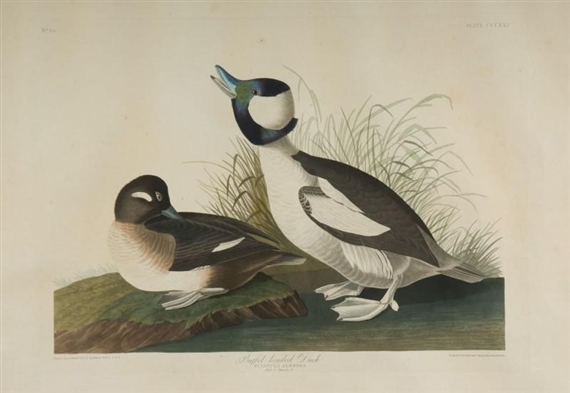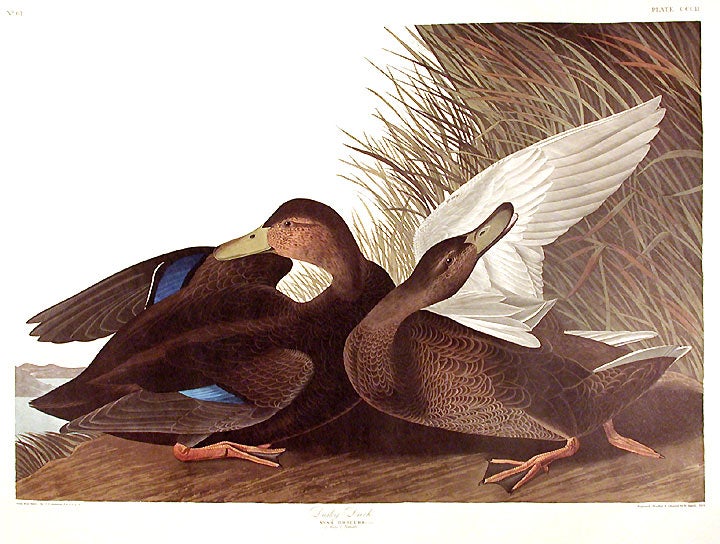P. M. — Sail to Bittern Cliff.
Scare up a flock of sheldrakes just off Fair Haven Hill, the conspicuous white ducks, sailing straight hither and thither. At first they fly low up the stream, but, having risen, come back half-way to us, then wheel and go up-stream.
Soon after we scare up a flock of black ducks.
J.J. Audubon (The flight of this Duck, which, in as far as I know, is peculiar to America, is powerful, rapid, and as sustained as that of the Mallard. While travelling by day they may be distinguished from that species by the whiteness of their lower wing-coverts, which form a strong contrast to the deep tints of the rest of their plumage See A Book of the Seasons, by Henry Thoreau, the American Black Duck)
There are a dozen sheldrakes (or goosanders) and among them four or five females. They are now pairing. I should say one or two pairs are made. At first we see only a male and female quite on the alert, some way out on the pond, tacking back and forth and looking every way. They keep close together, headed one way, and when one turns the other also turns quickly. The male appears to take the lead. Soon the rest appear, sailing out from the shore into sight.
We hear a squeaking note, as if made by a pump, and presently see four or five great herring gulls wheeling about. Sometimes they make a sound like the scream of a hen-hawk. They are shaped somewhat like a very thick white rolling-pin, sharpened at both ends. At length they alight near the ducks.
The sheldrakes at length acquire confidence, come close inshore and go to preening themselves, or it may be they are troubled with lice. They are all busy about it at once, continually thrusting their bills into their backs, still sailing slowly along back and forth offshore. Sometimes they are in two or three straight lines. Now they will all seem to be crossing the pond, but presently you see that they have tacked and are all heading this way again.
Among them, or near by, I at length detect three or four whistlers, by their wanting the red bill, being considerably smaller and less white, having a white spot on the head, a black back, and altogether less white, and also keeping more or less apart and not diving when the rest do.
Now one half the sheldrakes sail off southward and suddenly go to diving as with one consent. Seven or eight or the whole of the party will be under water and lost at once. In the mean while, coming up, they chase one another, scooting over the surface and making the water fly, sometimes three or four making a rush toward one.
At length I detect two little dippers, as I have called them, though I am not sure that I have ever seen the male before. They are male and female close together, the common size of what I have called the little dipper. They are incessantly diving close to the button-bushes.
[Rice says that the little dipper has a hen bill and is not lobe footed. He and his brother Israel also speak of another water-fowl of the river with a hen bill and some bluish feathers on the wings.]
The female is apparently uniformly black, or rather dark brown, but the male has a conspicuous crest, with, apparently, white on the hindhead, a white breast, and white line on the lower side of the neck; i. e., the head and breast are black and white conspicuously.
 |
| J J Audubon Fuligula albeola Buffle-headed Duck:" The bufflehead, being known in different districts by the names of Spirit Duck, Butter-box, Marrionette, Dipper, and Die-dipper, generally returns from the far north, where it is said to breed, about the beginning of September." |
Fair Haven Pond four fifths clear.
C. saw a phoebe, i e. pewee, the 25th. -
The sheldrake has a peculiar long clipper look, often moving rapidly straight forward over the water. It sinks to very various depths in the water sometimes, as when apparently alarmed, showing only its head and neck and the upper part of its back, and at others, when at ease, floating buoyantly on the surface, as if it had taken in more air, showing all its white breast and the white along its sides. Sometimes it lifts itself up on the surface and flaps its wings, revealing its whole rosaceous breast and its lower parts, and looking in form like a penguin.
When I first saw them fly up-stream I suspected that they had gone to Fair Haven Pond and would alight under the lee of the Cliff. So, creeping slowly down through the woods four or five rods, I was enabled to get a fair sight of them, and finally we sat exposed on the rocks within twenty five rods. They appear not to observe a person so high above them.
It was a pretty sight to see a pair of them tacking about, always within a foot or two of each other and heading the same way, now on this short tack, now on that, the male taking the lead, sinking deep and looking every way. When the whole twelve had come together they would soon break up again, and were continually changing their ground, though not diving, now sailing slowly this way a dozen rods, and now that, and now coming in near the shore. Then they would all go to preening themselves, thrusting their bills into their backs and keeping up such a brisk motion that you could not get a fair sight of one’s head.
From time to time you heard a slight titter, not of alarm, but perhaps a breeding-note, for they were evidently selecting their mates. I saw one scratch its ear or head with its foot.
Then it was surprising to see how, briskly sailing off one side, they went to diving, as if they had suddenly come across a school of minnows. A whole company would disappear at once, never rising high as before. Now for nearly a minute there is not a feather to be seen, and the next minute you see a party of half a dozen there, chasing one another and making the water fly far and wide.
When returning, we saw, near the outlet of the pond, seven or eight sheldrakes standing still in a line on the edge of the ice, and others swimming close by. They evidently love to stand on the ice for a change.
I saw on the 22d a sucker which apparently had been dead a week or two at least. Therefore they must begin to die late in the winter.
H. D. Thoreau, Journal, March 27,1858
Sheldrakes. See March 22, 1858 ("I see two of these very far off on a bright-blue bay where the waves are running high. They are two intensely white specks, which yet you might mistake for the foaming crest of waves. Now one disappears, but soon is seen again, and then its companion is lost in like manner, having dived."); March 5, 1857 ("I scare up six male sheldrakes, with their black heads, in the Assabet,—the first ducks I have seen"); March 16, 1855 ("Scare up two large ducks . . . I think it the goosander or sheldrake."); March 16, 1854 ("I see ducks afar, sailing on the meadow, leaving a long furrow in the water behind them.”) See also A Book of the Seasons, by Henry Thoreau, The Sheldrake (Merganser, Goosander)
Can this be the Fuligula albeola, and have I commonly seen only the female? Or is it a grebe? See January 15, 1858 ("At Natural History Rooms, Boston. Looked at the little grebe. Its feet are not webbed with lobes on the side like the coot, and it is quite white beneath."); December 26, 1857 ("The little dipper must, therefore, be different from a coot. Is it not a grebe?); April 19, 1855 ("A little duck, asleep with its head in its back, exactly in the middle of the pond. It has a moderate-sized black head and neck, a white breast, and seems dark-brown above, with a white spot on the side of the head, not reaching to the out side, from base of mandibles, and another, perhaps, on the end of the wing, with some black there. . . .I think it is the smallest duck I ever saw. Floating buoyantly asleep on the middle of Walden Pond. Is it not a female of the buffle-headed or spirit duck?"); December 26, 1853 ("Saw in it a small diver, probably a grebe or dobchick, dipper, or what-not, with the markings, as far as I saw, of the crested grebe, but smaller. It had a black head, a white ring about its neck, a white breast, black back, and apparently no tail.”); September 27, 1860 (" I see a little dipper in the middle of the river.. . .It has a dark bill and considerable white on the sides of the head or neck, with black between it, no tufts, and no observable white on back or tail.");April 22, 1861 (" [Mann] obtained to-day the buffle-headed duck, diving in the river near the Nine-Acre Corner bridge. I identify it at sight as my bird seen on Walden. ") See also A Book of the Seasons, by Henry Thoreau, The Little Dipper
They must begin to die late in the winter. See note to March 28, 1857 ("Every spring there are many dead suckers floating belly upward on the meadows. This phenomenon of dead suckers is as constant as the phenomenon of living ones; nay, as a phenomenon it is far more apparent.")




No comments:
Post a Comment